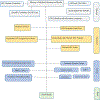HIV in Iran: onset, responses, and future directions
- PMID: 33252485
- PMCID: PMC7924262
- DOI: 10.1097/QAD.0000000000002757
HIV in Iran: onset, responses, and future directions
Abstract
Iran, a country in the Middle East and North Africa (MENA) region, has been actively involved in the fight against HIV/AIDS over the past three decades. The unique features of the HIV epidemic in Iran are reflected by the modes of transmission and its recent changes to improve management and prevention programs. In this review, we recount the initial onset and subsequent spread of HIV infection in Iran, beginning with the first case diagnosed to the ongoing responses and most recent achievements in controlling this epidemic. Although in the MENA region, Iran is one of the pioneers in implementing pertinent policies including harm reduction services to decrease HIV incidence, drug injection still continues to be the major risk of infection. In line with other nations, the programs in Iran aim at the UNAIDS 90-90-90 targets (UNAIDS 90-90-90 global targets to end the AIDS epidemic by 2020: by 2020, 90% of all people living with HIV will know their HIV status; 90% of all people with diagnosed HIV infection will receive sustained antiretroviral therapy; and 90% of all people receiving antiretroviral therapy will have viral suppression) and to eliminate mother-to-child HIV transmission. In this article, we discuss the strengths and shortcomings of the current HIV programs and offer suggestions to provide a better perspective to track and respond to the HIV epidemic. More generally, our account of the national religious and cultural circumstances as well as obstacles to the approaches chosen can provide insights for decision-makers in other countries and institutions with comparable settings and infrastructures.
Copyright © 2020 Wolters Kluwer Health, Inc. All rights reserved.
Conflict of interest statement
Conflict of Interest
The authors confirm that they have no conflict of interest.
Figures




References
-
- UNAIDS, Fact Sheet – Global AIDS Update, 2019. Available at: https://www.unaids.org/sites/default/files/media_asset/UNAIDS_FactSheet_....
-
- National AIDS Committee Secretariat and Ministry of Health and Medical Education, Islamic Republic of Iran AIDS progress report on monitoring of the United Nations general assembly special session on HIV and AIDS 2016.
-
- Gökengin D, Doroudi F, Tohme J, Collins B, Madani N. HIV/AIDS: trends in the Middle East and North Africa region. Int J Infect Dis 2016; 44:66–73. - PubMed
-
- UNAIDS. Regional factsheets, Middle East and North Africa. 2019, available at: https://www.unaids.org/en/regionscountries/middleeastandnorthafrica.
-
- Statistical Centre of Iran. Selected Findings of the 2016 National Population and Housing Census. 2018, https://www.amar.org.ir/Portals/1/census/2016/Census_2016_Selected_Findi....
Publication types
MeSH terms
Grants and funding
LinkOut - more resources
Full Text Sources
Medical
Research Materials
Miscellaneous

